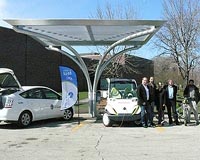 |
Winston-Salem, NC (SPX) Apr 06, 2011 A new polymer-based solar-thermal device is the first to generate power from both heat and visible sunlight - an advance that could shave the cost of heating a home by as much as 40 percent. Geothermal add-ons for heat pumps on the market today collect heat from the air or the ground. This new device uses a fluid that flows through a roof-mounted module to collect heat from the sun while an integrated solar cell generates electricity from the sun's visible light. "It's a systems approach to making your home ultra-efficient because the device collects both solar energy and heat," said David Carroll, Ph.D., director of the Center for Nanotechnology and Molecular Materials at Wake Forest University. "Our solar-thermal device takes better advantage of the broad range of power delivered from the sun each day." Research showing the effectiveness of the device appears in the March issue of the peer-reviewed journal Solar Energy Materials and Solar Cells. A standard, rooftop solar cell will miss about 75 percent of the energy provided by the sun at any given time because it can't collect the longest wavelengths of light - infrared heat. Such cells miss an even greater amount of the available daily solar power because they collect sunlight most efficiently between 10 a.m. and 2 p.m. "On a rooftop, you have a lot of visible sunlight and heat from the infrared radiation," Carroll said. "The solar-cell industry has for the most part ignored the heat." The design of the new solar-thermal device takes advantage of this heat through an integrated array of clear tubes, five millimeters in diameter. They lie flat, and an oil blended with a proprietary dye flows through them. The visible sunlight shines into the clear tube and the oil inside, and is converted to electricity by a spray-on polymer photovoltaic on the back of the tubes. This process superheats the oil, which would then flow into the heat pump, for example, to transfer the heat inside a home. Unlike the flat solar cells used today, the curve of the tubes inside the new device allows for the collection of both visible light and infrared heat from nearly sunrise to sunset. This means it provides power for a much greater part of the day than does a normal solar cell. Because of the general structure and the ability to capture light at oblique angles, this is also the first solar-thermal device that can be truly building-integrated - it can be made to look nearly identical to roofing tiles used today. Tests of the solar-thermal device have shown 30 percent efficiency in converting solar energy to power. By comparison, a standard solar cell with a polymer absorber has shown no greater than 8 percent conversion efficiency. The research team will build the first square-meter-size solar-thermal cell this summer, a key step in getting the technology ready for market.
Share This Article With Planet Earth
Related Links Wake Forest University All About Solar Energy at SolarDaily.com
 City to build solar carports with chargers
City to build solar carports with chargersCity Of Industry, Calif. (UPI) Apr 4, 2011 A Southern California community says it will build almost 1,000 solar carports at a commuter rail station to produce electricity and charge electric vehicles. The carports at the Metrolink station parking lot in the City of Industry will have photovoltaic solar roof panels to provide about 2 megawatts of power for Southern California Edison, the San Gabriel Valley Tribune reported Sunda ... read more |
|
| The content herein, unless otherwise known to be public domain, are Copyright 1995-2010 - SpaceDaily. AFP and UPI Wire Stories are copyright Agence France-Presse and United Press International. ESA Portal Reports are copyright European Space Agency. All NASA sourced material is public domain. Additional copyrights may apply in whole or part to other bona fide parties. Advertising does not imply endorsement,agreement or approval of any opinions, statements or information provided by SpaceDaily on any Web page published or hosted by SpaceDaily. Privacy Statement |